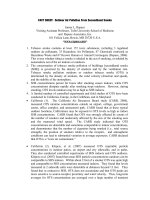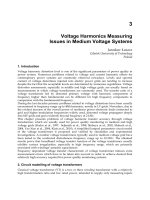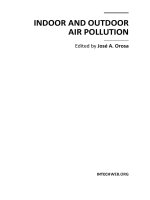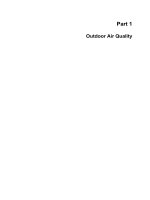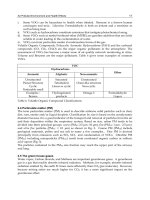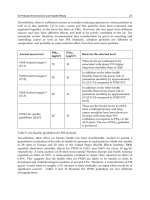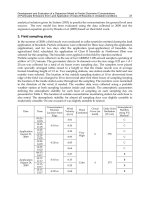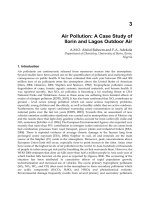Indoor and Outdoor Air Pollution Part 6 ppt
Bạn đang xem bản rút gọn của tài liệu. Xem và tải ngay bản đầy đủ của tài liệu tại đây (820.41 KB, 10 trang )
3
Air Pollution: A Case Study of
Ilorin and Lagos Outdoor Air
A.M.O. Abdul Raheem and F.A. Adekola
Department of Chemistry, University of Ilorin, Ilorin,
Nigeria
1. Introduction
Air pollutants are continuously released from numerous sources into the atmosphere.
Several studies have been carried out on the quantification of pollutants and analyzing their
consequences on public health. It has been estimated that each year between 250 and 300
million tons of air pollutants enter the atmosphere above the United States of American
[Dara, 2004; Onianwa, 2001; Stephen and Spencer, 1992]. Tropospheric pollution causes
degradation of crops, forests, aquatic systems, structural materials, and human health. It
was reported recently, that NO
x
air pollution is becoming a far reaching threat to USA
National Parks and Wilderness Areas as these areas are suffering from harmful effects of
oxides of nitrogen pollution [EDFS, 2003]. It has also been confirmed that NO
x
contributes to
ground – level ozone (smog) pollution which can cause serious respiratory problems,
especially young children and the elderly, as well as healthy adults that are active outdoors.
Furthermore, the same report confirmed worsening ozone concentration in nearly all the
national parks over the last ten years [EDFS, 2003]. Towards this, an assessment of new
vehicles emission certification standards was carried out in metropolitan area of Mexico city
and the results show that light duty gasoline vehicles account for most carbon (II) oxide and
NO
x
emissions [Schifter et al, 2006]. The European Environmental Agency also reported very
recently that more than 95% contribution to nitrogen oxides emission to the air comes from
fuel combustion processes from road transport, power plants and industrial boilers [EEA,
2006]. There is reported evidence of average chronic damage to the human lung from
prolonged ozone exposure [EEA, 2006]. Sulphur in coal, oil and minerals are the main
source of the Sulphur (IV) oxide in the atmosphere. Moreover, peak concentrations above
European Union limit still occur, especially close to point sources in the cities. Asian cities
have some of the highest levels of air pollution in the world. In Asia, hundreds of thousands
of people in urban areas get sick just by breathing the air that surrounds them. However, the
WHO 2006 estimates that dirty air kills more than half a million people in Asia each year of
which burden falls heaviest on the poor as reported by Ogawa, 2006. The worsening of the
situation has been attributed to cumulative effects of rapid population growth,
industrialization and increased use of vehicles. The ozone primary tropospheric pollutants
(SO
2
, NO
x
, HC
s
, and CO) often react in the atmosphere to form secondary pollutants which
are acidic compounds (H
2
CO
3
, H
2
SO
4
and HNO
3
) and photochemical oxidants.
Environmental damage frequently results from several primary and secondary pollutants
Indoor and Outdoor Air Pollution
42
acting in concert rather than from a single pollutant. Tropospheric oxidants such as ozone,
PBN, PAN illustrate the complexity of atmospheric chemistry and processes. They help to
form acidic compounds thereby contributing to green house warming and hence, damage to
human health, animal, plant life and materials [USEPA, 1998; Dara, 2004]. Significant
changes in stratospheric ozone, high above the troposphere, can affect tropospheric oxidants
level [USEPA, 1998]. If increased UV-B radiation penetrates a depleted ozone shield, the
photochemical formation of ground level oxidants may be enhanced [Stoker and Seager,
1972]. Green house warming could amplify this effect: A study carried out in three U.S.
cities; Nashville, Philadelphia, and Los Angeles showed that a large depletion of
stratospheric ozone, coupled with the green house warming, could increase smog formation
by as much as 50% [Adelman, 1987]. The study also showed that NO
2
concentration might
increase more than ten folds. There is however progress towards the reduction of
anthropogenic emissions of NO
x
, CO, volatile organic compounds in Europe and North
American [Jonson et al, 2001]. However, the concentration of air pollutants emitted into the
atmosphere is on the increase in the Southeast Asia and other parts of the World [Jonson et
al, 2001]. It is therefore expected that the emissions from Africa and other parts of the
Worlds that are yet to take strict and effective controlling measures on emissions will
influence the free tropospheric levels in most of the Northern Hemisphere.
During a five-day period marked by temperature inversion and fog in London in 1952,
between 3,500 and 4,000 deaths in excess of normal occurred with 1.3 ppm SO
2
level
recorded [O’Neill, 1993; ACGIH, 1991]. SO
2
is oxidized to SO
3
in the atmospheric air by
photolytic and catalytic processes involving ozone, oxides of nitrogen (NOx), and
hydrocarbon (HC), giving rise to the formation of photochemical smog [Dara, 2004].
In contrast to NO
2
, SO
2
is deleterious to plant life [Haagen-Smith, 1952; Molski and
Dmuchowski, 1986]. Air pollution causes the decline in Eastern Europe [Nihlgard, 1985;
Schutt and Cowling, 1985]. Area with extensive large-scale forest decline correlate with the
areas where SO
2
concentration were elevated [ECE, 1984; Molski and Dmuchowski, 1986],
therefore If the concentration of SO
2
is higher along with other gaseous pollutants (NO
x
, O
3
,
HC, organic and inorganic peroxides etc) in the troposphere and continues to accumulate
over time, the overall concentration can have a negative effect on health, vegetation and
structures [Abdul Raheem, 2007; Abdul Raheem et al., 2009
a
].
Surface concentration of ozone has been reported to be on the increase in the last decades in
northern hemisphere [Vautard et al., 2007] and in Southeast Asia [Jaffe, 1999]. A rise of
about 26% in the ambient concentration of ozone has been reported in Taiwan between 1994
and 2003 [Chou et al., 2006]. High levels of ambient air ozone can cause serious damage to
health. The health hazards include shortness of breath, nausea, eye and throat irritation, and
lung damage [Menezes and Shively, 2001]. Identification of air pollution source
characteristics is an important step in the development of regional air quality control
strategies. Receptor modeling, using measurements of pollutant concentrations at one or
more sample sites, is often a reliable way to provide information regarding source regions
for air pollution [Watson, 1984]. One of such receptor-modeling technique is principal
component analysis (PCA) [Einax and Geiss, 1997; Jackson, 1991; Norman, 1987]. This is
often combined with multiple linear regression (MLR), principal component regression
(PCR), and partial least square regression, which have been demonstrated as powerful tools
for handling several environmental problems, especially source apportioning [Otto, 1999;
Timm, 1985; Vogt, 1989].
Air Pollution: A Case Study of Ilorin and Lagos Outdoor Air
43
In recent years, certain statistical techniques that incorporate the influence of meteorological
variables have been applied to asses the trend in ozone levels in the ambient air [Bakken et
al., 1997]. One common approach is the use of a parametric regression model to link some
characteristics of ozone, such as the mean level of ozone to meteorological variables. Other
scientists have equally used PCA to pattern the spatial and temporal variations of ozone and
to identify the important factors influencing ozone concentration [Klaus et al., 2001; Lengyel
et al., 2004; Pissimanis et al., 2000]. Different subregions have, however, been identified
where ozone concentration exhibited characteristic spatial and temporal patterns based on
the differences arising from the interaction of their respective meteorological conditions
with anthropogenic effects [Alvarez et al., 2000]. More specifically, Bloomfield et al., (1996)
established a nonlinear regression model for hourly ozone data in the Chicago area in which
meteorological variables, seasonality, and a trend term were all implicated. Cox and Chu
(1992), on their part, proposed a model for the daily maxima of hourly ozone concentrations
based on the Weibull distribution in which the scale parameter is allowed to vary as a
function of meteorological conditions. On the other hand, Menezes and Shively (2001) used
a multivariate approach to estimate the long-term trend in the extreme values of
tropospheric ozone in Houston and Texas. They found that there is a downward trend in the
probability of an exceedance followed by a relative flat trend. Shively and Sager (1999)
extended the work of Cox and Chu (1992) as well as Bloomfield et al., (1996) by using
nonparametric regression models to model ozone. The use of multivariate methods was
further supported by Lengyel et al., (2004) who analyzed air quality data of which the
hidden structure was uncovered by factor analysis and modeled ozone concentration using
MLR, PLS, and PCR. While PCA is a very useful tool for selection of properties and different
qualities processes leading to a linear model of the data, MLR and PCR or PLS can predict
ozone concentration with an error below 2, 5, and 1ppb levels, respectively.
The aim of the present investigation was therefore to analyze environmental data gathered
on the daily monitoring of ambient ozone, oxides of nitrogen, and sulfur (IV) oxide at five
monitoring sites in Lagos and four monitoring sites in Ilorin, Nigeria. The data were
collected between early morning and late evening of the day, and they covered both dry and
wet seasons from years 2003 to 2006. The study also included establishment of prediction
models on the influence of meteorological parameters on the seasonal variation of
concentration of gaseous pollutants in the two Nigerian cities and comparison of measured
and modeled concentration values of ozone [Abdul Raheem et al., 2009
b
].
2. Theoretical background
2.1 Air pollution
Air is all around us, odourless, colourless and essential to all life on earth as it acts as a
gaseous blanket, protecting the earth from dangerous cosmic radiation from outer space. It
helps in sustaining life on earth by screening the dangerous ultraviolet (UV) radiations (<
300nm) from the sun and transmitting only radiations in the range 300nm to 2500nm,
comprising of near UV, visible and near infrared (IR) radiations and radio waves (0.01 to 4 x
10
5
nm) [Smart, 1998]. The atmosphere also plays a vital role in maintaining the heat balance
on the earth by absorbing the IR radiation received from the sun and re-emitted by the
earth. In fact, it is this phenomenon, called “the greenhouse effect”, which keeps the earth
warm enough to sustain life on the earth. Yet, the air is actually a combination of gaseous
Indoor and Outdoor Air Pollution
44
elements that have a remarkable uniformity in terms of their contribution to the totality of
life. Thus, oxygen supports life on earth; nitrogen is an essential macro - nutrient for plants;
and carbon (IV) oxide is essential for photosynthetic activity of plants. Moreover,
atmosphere is a carrier of water from the ocean to land, which is so vital for the hydrological
cycle. Any major disturbance in the composition of the atmosphere resulting from
anthropogenic activities may lead to disastrous consequences or may even endanger the
survival of life on earth [Dara, 2004]. The constituent elements are primarily nitrogen and
oxygen, with a small amount of argon. Below 100km, the three main gaseous elements,
which account for about 99.9% of the total atmosphere, are N
2
, O
2
and Ar and they have
concentration by volume of 78%, 21%, and 0.93% of respectively [Stanley, 1975]. The
presence of trace amounts of other gases would account for the remaining 0.07%. These
remaining trace gases exist in small quantities and they are measured in terms of a mixing
ratio. This ratio is defined as the number of molecules of the trace gas divided by the total
number of molecules present in the volumes sampled. For example, ozone (O
3
), carbon (IV)
oxide (CO
2
), oxides of nitrogen (NO
2
+ NO) as NO
x
and chloro fluoro carbons (CFCs) are
measured in parts per million by volume (ppmv), parts per billion by volume (ppbv) as well
as microgram per cubic meter (µgm
-3
), [Dale, 1976]
Air pollution has been defined [World Bank, 1978] as ‘the presence in the outdoor
atmosphere of one or more contaminants such as dust, fumes, gas, mist, odour, smoke, or
vapour in such quantity, characteristics and duration as to make them actually or potentially
injurious to human, plant or animal life, or property, or which unreasonably interferes with
the comfortable enjoyment of life and property’. Pollution on the whole is caused principally
by human activities, though it can also be a natural process. Air pollution arises from
people’s economic and domestic activities like modern agriculture which requires
agrochemicals. Industrial activities are responsible for wide range of pollution. Thermal
power station, burning fossil fuel and moving vehicles emit harmful pollutants like sulphur
(IV) oxide, nitrogen (II) oxide and carbon (IV) oxide. Some of these emitted gases have been
responsible for acid – rain, global warming and malfunctioning of human / animal’s
haemoglobin [Stanley, 1975]. Other causes arising from human activities include
inappropriate solid waste disposal, gas flaring and oil exploration. Air pollution can also
arise from natural causes such as volcanic eruption, whirlwind, earthquake, decay of
vegetation, pollen dispersal, as well as forest fire ignition by lightning.
2.2 Pollutants
These are substances introduced into the environment in an amount sufficient to cause
adverse measurable effects on human beings, animals, plant, vegetation or materials.
Pollutants are referred to as primary pollutants, if they exert the harmful effects in the
original form in which they enter the atmosphere e.g. CO, NO
x
, HC
s
, SO
x
, particulate matter
and so on. On the other hand, secondary pollutants are products of chemical reactions,
among primary pollutants are ozone, hydrogen peroxide, peroxyacetylnitate (PAN) and
peroxybenzoyl nitrate (PBN). Classification of pollutants can also be according to chemical
compositions i.e. organic or inorganic pollutants or according to the state of matter i.e.
gaseous or particulate pollutants. Air pollution is basically made up of three components
and these are source of pollutants, the transporting medium, which is air and target or
receptor which could be man, animal, plant and structural facility.
Air Pollution: A Case Study of Ilorin and Lagos Outdoor Air
45
Fig. 1. Generalized Plot of Atmospheric Concentrations of Species Involved In Smog
Formation As A Function of Time of The Day
3. Atmospheric photochemical reactioN
The various chemical and photochemical reactions taking place in the atmosphere mostly
depend upon the temperature, composition, humidity and the intensity of sun light. Thus
the ultimate fate of chemical species in the atmosphere depends upon these parameters.
Photochemical reactions take place in the atmosphere by the absorption of solar radiations
in the UV region. Absorption of photons by chemical species gives rise to electronically
excited molecules. These reactions are not possible under normal laboratory conditions
except at higher temperature and in the presence of chemical catalysts [Hansen et al, 1986].
The electronically excited molecules spontaneouslyundergo any one or combination of the
following transformations: Reaction with other molecules on collision; Polymerization;
Internal rearrangement; Dissociation; De - excitation by fluorescence or De - activation to
Fig. 2. Generalized Scheme For The Formation Of Photochemical Smog
Indoor and Outdoor Air Pollution
46
return to the original state [Dara, 2004]. Any of these transformation pathways may serve as
an initiating chemical step or a primary process. The three steps involved in an overall
photochemical reaction are Absorption of radiation, Primary reactions and Secondary
reactions.
Smoggy atmosphere show characteristics variations with time of the day in levels of NO,
NO
2
, hydrocarbons, aldehydes and oxidants. A generalized plot showing these variations is
shown in Figure 1. This shows that shortly after dawn the level of NO in the atmosphere
decreases markedly, a decrease which is accompanied by a peak in the concentration of
NO
2
. During the mid – day the levels of aldehydes and oxidants become relatively high,
however, the concentration of total hydrocarbons in the atmosphere peaks sharply in the
morning, then decreases during the remaining daylight hours. The variations in species
concentration shown in the above Figure 1 may be explained by a generalized reaction
scheme in Figure 2. This is based on the photochemically initiated reactions which occur in
an atmosphere containing oxides of nitrogen, reactive hydrocarbons, and oxygen. The
various chemical species that can undergo photo - chemical reactions in the atmosphere
include NO
2
, SO
2
, HNO
3
, N
2
, ketones, H
2
O
2
, organic peroxides and several other organic
compounds and aerosols; the time – variations of which are explained in a group of overall
reactions first proposed by Friedlander nd Seinfeld (1974)
* Primary photochemical reaction:
NO
2
+ hע
NO + O (1)
* Reactions involving oxygen species
O
2
+ O + M
O
3
+ M (2)
(M is an energy absorbing third body)
O
3
+ NO NO
2
+ O (3)
* Production of organic free radicals from hydrocarbons,
RHO + RH
R
.
+ other products (4)
O
3
+ RH R
.
+ other products (5)
R
.
is a free radical, which may or may not contain oxygen
* Chain propagation, branching and termination
NO + R
.
NO
2
+ R
1
(6)
In this case R
.
contains oxygen and oxidizes NO. It is one of many chain propagation
reactions, some of which involve NO
NO
2
+ R
.
products (e.g. PAN) (7)
A number of specific reactions are involved in the above overall scheme for the formation of
photochemical smog, which is smoke and fog [Thomas et al, 1974]. The formation of atomic
oxygen by the primary photochemical reaction:
NO
2
+ hט NO + O
Air Pollution: A Case Study of Ilorin and Lagos Outdoor Air
47
This leads to several reactions involving oxygen and nitrogen oxide species. Examples of
such reactions are given below:
O + O
2
+M O
3
+ M (8)
O + NO + M NO
2
+ M (9)
O + NO
2
NO + O
2
(10)
O
3
+ NO NO
2
+ O
2
(11)
O + NO
2
+ M NO
3
+ M (12)
O
3
+ NO
2
NO
3
+ O
2
(13)
Pollutant Source CO NOx HC SOx Particulate Total
Transportation 111.0 11.7 19.5 1,0 0.7 143.9
Fuel Combustion
(Stationary Source)
0.8
10.0
0.6 26.5
6.8 44,7
Industrial Processes 11.4 0.2 5.5 6.0 13.1 36.2.
Solid wastes disposal 7,2 0.4 2.0 0.1 1.4 11.1
Miscellaneous 16.8 0.4 7.1 0.3 3.4 28.0
Total 147.2 22.7 34.7 33.9 25.4 263.9
[Adapted from Thomas et al, 1974]
Table 1. Estimates of USA Primary Pollutants Sources in million tons per year (Million
Tons/Year)
4. Methodology
The determinations of the concentrations of total oxidants (undertaken as O
3
), NO
X
and SO
2
in
the ambient air were carried out between 2003 and 2006 to cover the two seasons; dry season
(November to April) and rainy season (May to October) using standard methods. Total
oxidants were determined by buffered potassium iodide solution method proposed by Byers
and Saltzman
(1958). Determination of oxides of nitrogen concentrations were done using the
Intersociety Committee Method of Analysis (1972) which is based on the Griess–Saltzman
(1954) colorimetric, azo dye forming reagent while oxides of sulphur were determined by
conductivity measurements as proposed by Stanley (1975). The application of these techniques
to monitoring required the preparation of the following range of reagents as sampling and
absorbing solutions as well as preparation of calibration curves. All the chemicals used in the
preparation of sampling and absorbing solutions were of analytical grade. The reagents had
been prepared and seen stable for months prior to their use. The validation of all procedures
was further confirmed using LaMotte standard air sampler.
Indoor and Outdoor Air Pollution
48
4.1 Ozone
The absorbing solution used for trapping ozone was 1% KI buffered at 6.8 ± 0.2. The
standard solution and calibration curve were prepared as follows: 4.09ml of standard
0.001M iodine solution was taken and diluted to 100ml with distilled water. 10ml of this
solution was taken and further diluted to 100ml with absorbing reagent and this was
labelled solution A. 1ml of A was further diluted to 100ml using absorbing reagent, which
gives solution B. This provides a calibrated iodine solution equivalent to 1.92μg of ozone per
ml [Stanley, 1975 and Dara, 2004] as ozone reacts with iodine ion in neutral buffer solution
according to the following equation:
O
3
+ 3I
-
+ H
2
O I
3
-
+ 2 OH
-
+ O
2
(14)
The tri – iodide ion liberated has an intense yellow colour. The standard solution was
always prepared freshly when needed. A series of standard solutions prepared from above
were used to obtain calibration curve. The absorbance measurement was carried out at
352nm. The calibration curve is shown in Figure 3 and it has regression value of 0.9972
y = 0.001x
R² = 0.9977
0
0.05
0.1
0.15
0.2
0.25
0.3
0.35
0.4
0.45
0 100 200 300 400 500
ABSORBANCE
CONCENTRATION
(μg / 10ml)
Fig. 3. Total oxidants calibration curve
4.1.1 Sampling procedure
The set-up of the high volume sampler is given in Figure 4. To follow strict guidelines
needed when monitoring for criteria pollutants as discussed earlier, our equipment is
validated with LaMotte air sampler (Figure 5) purchased from LaMotte & Company, USA,
for capability, repeatability and reliability needed to collect accurate data, and operation of
the equipment within our established methods. The impinger used is a big boiling tube of
capacity 250cm
3
with 42mm diameter. Teflon tubing’s used as delivery tubes along with
Air Pollution: A Case Study of Ilorin and Lagos Outdoor Air
49
Fig. 4. Picture of The Sampling train
Fig. 5. Lamotte Air- Sampler
glass tubing that serves as inlet for the ambient air sampled. Silicone grease was used to
make the set up airtight by it application to all necessary joints. The air was sampled at the
rate of 1 dm
3
min
-1
with absorbing solution fixed at 30 cm
3
as found appropriate and used
[Abdul Raheem et al., 2009
c
], after each sampling for one hour, the impinger was carefully
removed and the sample transferred quantitatively into the sample bottle for analysis. The
impinger was wrapped with aluminum foil to avoid sunrays’ interference. In order to
determine pollutant variability over daytime periods, air samples were taken at each
location over ten defined sixty - minute periods for any sampling day. The ten sampling
periods were spaced equally between approximately 6 am and 6 pm to reflect morning,
afternoon and evening. Minimum of 30 samples were collected at each site per week for the
pollutants monitored. The time of sixty minutes was found to be optima from the
preliminary investigations for the quantitative sampling of these toxic gases within the
Indoor and Outdoor Air Pollution
50
environment [Abdul Raheem et al., 2009
c
]. All samplings reported were carried out in
triplicates. As the road traffic is the common source of pollution cutting across all sites
classes, the average traffic volume were determined for all sampling zones. Traffic count
was manually done, counting the vehicles passing on the road for 10 minutes in every hour
from which hourly traffic was calculated [Abam and Unachukwu, 2009].
The daily minimum and maximum temperatures were between 23°C and 36.5°C,
throughout the sampling period.
4.1.2 Analysis
A freshly prepared absorbing solution serves as sample reference or blank solution in order
to take care of any impurities during preparation. Absorbance of samples for total oxidants
was measured at 352 nm with UV / Visible spectrophotometer. The concentration was read
out in μg / 10ml from the reference plot of which one of the examples is shown in Figure 3.
The concentrations were converted to μgm
-3
or ppm or ppb using appropriate conversion
factor.
4.1.3 Calculation [Vowels and Connell, 1980]
3
3
total
g
Oper 10ml of absorbin
g
rea
g
ent
Oxidant gm
Volume of air sampled in cubic metres
(15)
3
X
M
O
O
V
(16)
3
1000
24.45
ppb molar mass
gm
(17)
for 1 μgm
-3
of ozone, the ppb value will be
1 24.45
0.51
48 1000
p
pb
(18)
QUANTITY CONTENTS CODE
2 × 120 Ml Total oxidants reagent #1 7740-J
30Ml Total oxidants reagent #2 7741-G
30Ml Total oxidants reagent #3 7742-G
3 Test Tubes, 5mL, w/ caps 0230
1 Total oxidants in Air Comparator 7739
Table 2. LaMotte total oxidants in air test kit code 7738

